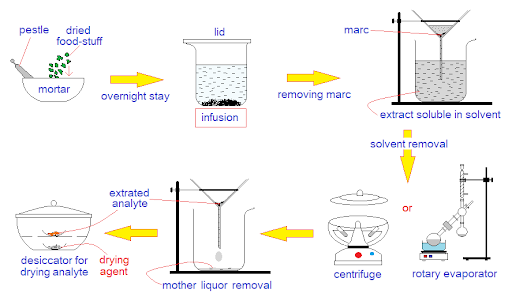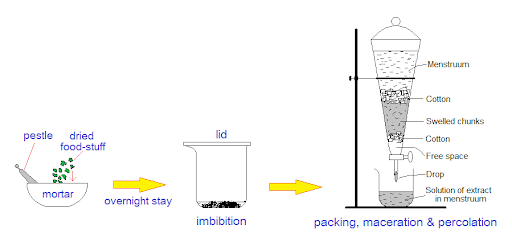Author: Dr. Mudassar Altaf
Associate Professor of Chemistry
Government of the Punjab, Pakistan
The copy of the content is not allowed
Digestion, maceration, infusion, decoction and percolation are usual laboratory techniques for the extraction of active ingredients from the food-stuff. This write-up provides an introduction of these procedures.
Contents:
⦁ Digestion
⦁ Maceration
⦁ Infusion
⦁ Decoction
⦁ Percolation
⦁ Digestion
The dried fine particles of food-stuff are soaked in warm water for about few minutes to several hours is called digestion. The boiling water is not used during digestion. The food-stuff is consisted of analyte and the matrix. Analyte is the compound that is required to be separated for analysis; while matrix is the constituent that is other than an analyte. The solvent is known as menstruum that is used for extraction. After appropriate time of the soaking, the filtration is carried out. The residue is not required and is known as marc. Digestion method is a better technique for hard stuff, for example, fennel seeds (saunf), cumin seeds (zeera or jeera), coriander seeds (dhania) or ginger (adrak).
By means of centrifugation or at reduced pressure rotary evaporator the solvent is removed. Subsequently, the whatman filter paper is used for further removing the mother liquor and then dried in desiccator. Mother liquor can easily be removed under reduced pressure filtration.
⦁ Maceration
The term maceration is derived from a Latin word ‘macerare’, and having the meaning of ‘making soft’ the hard stuff by soaking into solvent at room temperature. The stuff like roots, seeds, leaves, roots, flowers are first of all washed, then dried. The dried stuff is grinded to get fine particles; subsequently, added into a solvent such as methyl alcohol, ethyl alcohol or water. The glass vessel is covered with lid for two to four weeks; however, keep on mixing with a rod twice a day. Gradually, the colour of the solvent begins to change, indicating the extraction is taking place. When the colour changes completely, the extraction is complete. Thereafter, filter to remove marc and the menstruum of filtrate contains the extracted analyte. Moreover, the solvent is removed as described above.
⦁ Infusion
The infusion is similar to maceration except the number of days involved. Few hours are enough for infusion rather than weeks; usually 10-12 hours. The Latin word ‘infus’ means ‘pouring into’ from which infusion term derived. The stuff is crushed into smaller pieces or grinded to a powder form, then added into solvent. Usually, a mixture of the water with ethyl alcohol is used with 1:1 ratio. However, dimethyl ketone, or dimethyl sulfoxide (DMSO) are also used as solvent. The solvent is removed as described above.
The curcumin is a bioactive anti-inflammatory component exists in turmeric (haldi) and ginger. The curcumin is extracted by infusion. It contains various compounds, such as desmethoxycurcumin (C20H18O5), bisdemethoxycurcumin (C19H16O4), and can be separated by column chromatography.

⦁ Decoction
The decoction is derived from a Latin word ‘decoctio’, meaning ‘boiling’. In decoction, the powder or chunks of food-stuff are boiled for 10 to 15 minutes in water; so that the analyte is extracted out into the water. The particles of residue are removed by filtration or straining by sieve. Tea making is a good example of this method.
⦁ Percolation
The ‘percolatio’ is a Latin word, meaning ‘straining’ by using sieve or doing ‘filtration’. Percolatio is a combined form of ‘per’ and ‘colare’; ‘per’ means ‘through’ while ‘colare’ means ‘strain’, i.e., pouring through a porous material. The percolation procedure has these five steps; comminution, imbibition, packing, maceration, and percolation; described below.
⦁ Comminution: The ‘comminutio’ is a Latin word, meaning ‘making powder’, i.e., pulverizing, chopping, crushing/ crumbling. Thus, this step belongs crushing of the food-stuff.
⦁ Imbibition: The soaking or dipping of the stuff into the solvent is called imbibition. The solvent like water is added just to the level of chunks. Allow the imbibition for about 7 hours. The chunks will absorb the solvent and will swell up. Imbibe is a verb meaning to absorb or drink. Ispaghol husk, basil seeds (tukham Balanga) are common examples of observation in our kitchen. Packing: Percolation is carried out in a glass funnel similar to a separating funnel; in other words, it is cone-shaped glass vessel. Place a piece of filter paper or cotton almost at the bottom of that funnel by leaving some empty space below this packing. Use washed and dry funnel and keep its stopcock turned off. Then, over to the cotton, fill up the funnel with pieces of the swollen stuff imbibed the solvent at the previous step. Following that, cover with another piece of cotton. On the top of upper cotton layer, pour the same solvent that was used during imbibition. At the end, cover the apparatus with a lid and set aside for a day with its orifice at the bottom closed.
⦁ Maceration: During stay for a longer period of time, the solvent moves down towards swollen chunks by passing through cotton. These chunks are soaked and resultantly, maceration takes place, due to solvent wetting them. Solvent, then enters the free space between lower layer of the cotton and orifice. Enough time should be given to the solvent to flow to this free space. Keep the stopcock turned off.
⦁ Percolation: After maceration, turn the stopcock to open up the orifice and allow to drip down the menstruum into a beaker; after collection, turn off the stopcock. Pour more solvent from the top almost equal to the quantity discharged in the beaker; and hold-up for maceration for second time, and set aside for one next day even. Repeat the same step and get solvent discharged into the same beaker. This is a cyclic process and performed many times as late as the solvent’s dark shade begins to faint gradually. It means, the extraction of the compound from the food-stuff has stopped further. The percolation is a slow-going procedure and might be completed in 48 hours or more. Purification of underground water is a good example under natural percolation. The rain water penetrates in the soil and purified by the same procedure.

Key words: Extraction of organic analyte, active ingredients from food stuff, infusion, maceration, digestion, decoction, percolation

